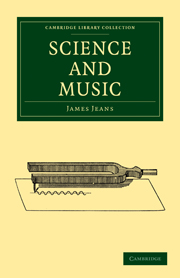Chapter VI - The Concert Room
Published online by Cambridge University Press: 07 September 2010
Summary
We have now considered the way in which musical sounds are produced by various instruments, and the way in which the quality of those sounds depends on the proportion of the various harmonics of which they are the blend. We have further considered the combining of single sounds into chords, and the choice of a musical scale which shall give as much pleasure as possible—or, perhaps, more accurately, as little pain as possible—to the sensitive ear. But our problem does not end with the production of musical tone; it ends only with the perception of this tone by the brain. After a musical tone has been produced in the orchestra, it has to go through two further stages—transmission from the instrument to the ear-drum of the listener, and transmission from his ear-drum to his brain. We consider these two stages in this and the following chapter.
The Transmission of Sound-Waves
Imagine that we are listening to an orchestra out in interstellar space. As we have seen that some material medium is necessary to transmit the sound from the instruments to our ear-drums, let us give free rein to our fancy, and imagine interstellar space filled with ordinary air.
Sound leaves each instrument in the form of waves which spread in all directions. If there is nothing to absorb their energy, they travel on for ever, but their intensity naturally diminishes as they spread out.
- Type
- Chapter
- Information
- Science and Music , pp. 191 - 216Publisher: Cambridge University PressPrint publication year: 2009First published in: 1937

